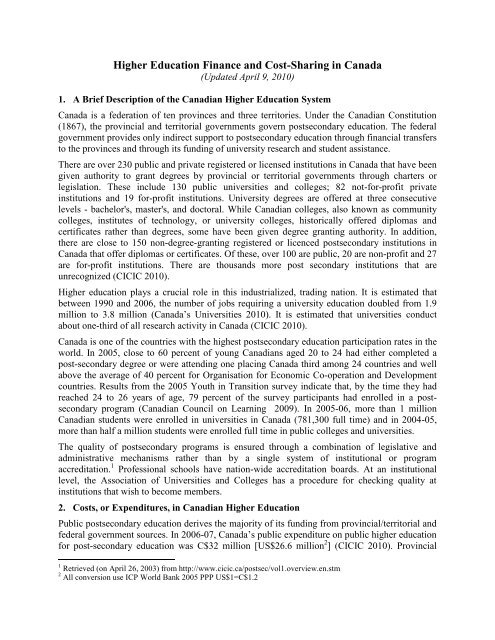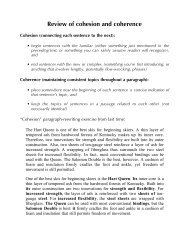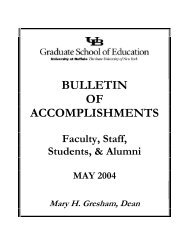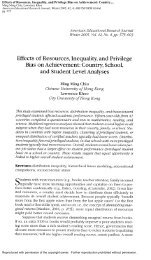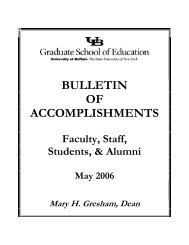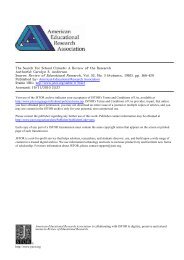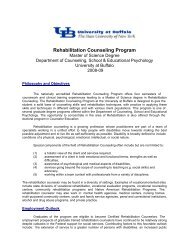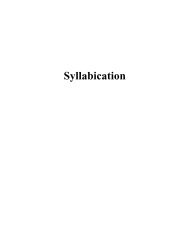Higher Education Finance and Cost-Sharing in Canada
Higher Education Finance and Cost-Sharing in Canada
Higher Education Finance and Cost-Sharing in Canada
You also want an ePaper? Increase the reach of your titles
YUMPU automatically turns print PDFs into web optimized ePapers that Google loves.
<strong>Higher</strong> <strong>Education</strong> <strong>F<strong>in</strong>ance</strong> <strong>and</strong> <strong>Cost</strong>-<strong>Shar<strong>in</strong>g</strong> <strong>in</strong> <strong>Canada</strong>(Updated April 9, 2010)1. A Brief Description of the Canadian <strong>Higher</strong> <strong>Education</strong> System<strong>Canada</strong> is a federation of ten prov<strong>in</strong>ces <strong>and</strong> three territories. Under the Canadian Constitution(1867), the prov<strong>in</strong>cial <strong>and</strong> territorial governments govern postsecondary education. The federalgovernment provides only <strong>in</strong>direct support to postsecondary education through f<strong>in</strong>ancial transfersto the prov<strong>in</strong>ces <strong>and</strong> through its fund<strong>in</strong>g of university research <strong>and</strong> student assistance.There are over 230 public <strong>and</strong> private registered or licensed <strong>in</strong>stitutions <strong>in</strong> <strong>Canada</strong> that have beengiven authority to grant degrees by prov<strong>in</strong>cial or territorial governments through charters orlegislation. These <strong>in</strong>clude 130 public universities <strong>and</strong> colleges; 82 not-for-profit private<strong>in</strong>stitutions <strong>and</strong> 19 for-profit <strong>in</strong>stitutions. University degrees are offered at three consecutivelevels - bachelor's, master's, <strong>and</strong> doctoral. While Canadian colleges, also known as communitycolleges, <strong>in</strong>stitutes of technology, or university colleges, historically offered diplomas <strong>and</strong>certificates rather than degrees, some have been given degree grant<strong>in</strong>g authority. In addition,there are close to 150 non-degree-grant<strong>in</strong>g registered or licenced postsecondary <strong>in</strong>stitutions <strong>in</strong><strong>Canada</strong> that offer diplomas or certificates. Of these, over 100 are public, 20 are non-profit <strong>and</strong> 27are for-profit <strong>in</strong>stitutions. There are thous<strong>and</strong>s more post secondary <strong>in</strong>stitutions that areunrecognized (CICIC 2010).<strong>Higher</strong> education plays a crucial role <strong>in</strong> this <strong>in</strong>dustrialized, trad<strong>in</strong>g nation. It is estimated thatbetween 1990 <strong>and</strong> 2006, the number of jobs requir<strong>in</strong>g a university education doubled from 1.9million to 3.8 million (<strong>Canada</strong>’s Universities 2010). It is estimated that universities conductabout one-third of all research activity <strong>in</strong> <strong>Canada</strong> (CICIC 2010).<strong>Canada</strong> is one of the countries with the highest postsecondary education participation rates <strong>in</strong> theworld. In 2005, close to 60 percent of young Canadians aged 20 to 24 had either completed apost-secondary degree or were attend<strong>in</strong>g one plac<strong>in</strong>g <strong>Canada</strong> third among 24 countries <strong>and</strong> wellabove the average of 40 percent for Organisation for Economic Co-operation <strong>and</strong> Developmentcountries. Results from the 2005 Youth <strong>in</strong> Transition survey <strong>in</strong>dicate that, by the time they hadreached 24 to 26 years of age, 79 percent of the survey participants had enrolled <strong>in</strong> a postsecondaryprogram (Canadian Council on Learn<strong>in</strong>g 2009). In 2005-06, more than 1 millionCanadian students were enrolled <strong>in</strong> universities <strong>in</strong> <strong>Canada</strong> (781,300 full time) <strong>and</strong> <strong>in</strong> 2004-05,more than half a million students were enrolled full time <strong>in</strong> public colleges <strong>and</strong> universities.The quality of postsecondary programs is ensured through a comb<strong>in</strong>ation of legislative <strong>and</strong>adm<strong>in</strong>istrative mechanisms rather than by a s<strong>in</strong>gle system of <strong>in</strong>stitutional or programaccreditation. 1 Professional schools have nation-wide accreditation boards. At an <strong>in</strong>stitutionallevel, the Association of Universities <strong>and</strong> Colleges has a procedure for check<strong>in</strong>g quality at<strong>in</strong>stitutions that wish to become members.2. <strong>Cost</strong>s, or Expenditures, <strong>in</strong> Canadian <strong>Higher</strong> <strong>Education</strong>Public postsecondary education derives the majority of its fund<strong>in</strong>g from prov<strong>in</strong>cial/territorial <strong>and</strong>federal government sources. In 2006-07, <strong>Canada</strong>’s public expenditure on public higher educationfor post-secondary education was C$32 million [US$26.6 million 2 ] (CICIC 2010). Prov<strong>in</strong>cial1 Retrieved (on April 26, 2003) from http://www.cicic.ca/postsec/vol1.overview.en.stm2 All conversion use ICP World Bank 2005 PPP US$1=C$1.2
<strong>and</strong> territorial governments provide most of the direct fund<strong>in</strong>g for public education <strong>in</strong> <strong>Canada</strong> (45percent). The balance of public postsecondary education <strong>in</strong>come is obta<strong>in</strong>ed from tuition fees (21percent), sale of goods <strong>and</strong> services (14.6 percent), federal government (9.3 percent), <strong>in</strong>vestment<strong>in</strong>come (2.7 percent), <strong>and</strong> other <strong>in</strong>come <strong>in</strong>clud<strong>in</strong>g philanthropic contributions (7.4 percent).S<strong>in</strong>ce the early 1990s, university tuition fees have accounted for an <strong>in</strong>creas<strong>in</strong>g proportion ofuniversity revenues. Average undergraduate university tuition <strong>in</strong>creased by 144 percent between1990/91 <strong>and</strong> 2001/02 (Lev<strong>in</strong> 2009). In the late 1990s, <strong>in</strong>creases <strong>in</strong> average general undergraduatetuition rates came to a halt <strong>and</strong> some prov<strong>in</strong>ces <strong>in</strong>stituted tuition freezes as part of theircommitment to <strong>in</strong>crease participation among lower <strong>in</strong>come students. At the same time, tuitionfee <strong>in</strong>creases surged by as much as 100 percent <strong>in</strong> some professional, graduate or second-entryprograms between 1999 <strong>and</strong> 2008. Average tuition fees <strong>in</strong>creased only by 22 percent between2001/02 <strong>and</strong> 2006/07 though there is some expectation that they will be allowed to <strong>in</strong>crease <strong>in</strong>the years ahead <strong>in</strong> the face of decl<strong>in</strong><strong>in</strong>g <strong>in</strong>stitutional revenues due to decreases <strong>in</strong> returns fromuniversity endowments <strong>and</strong> to decreases <strong>in</strong> government fund<strong>in</strong>g levels, <strong>in</strong>creas<strong>in</strong>g <strong>in</strong>structionalcosts, <strong>in</strong>creas<strong>in</strong>g enrollments, <strong>and</strong> <strong>in</strong>creas<strong>in</strong>g student aid costs (Lev<strong>in</strong> 2009; Usher <strong>and</strong> Dunn2009).The average student can cover his/her costs us<strong>in</strong>g a comb<strong>in</strong>ation of employment (average 27percent of <strong>in</strong>come <strong>in</strong> a given year), followed by government loans (19 percent of total <strong>in</strong>come),sav<strong>in</strong>gs <strong>and</strong> <strong>in</strong>vestment (15 percent), family support (12 percent), private loans (7 percent),government non-repayable aid (6 percent), other grants (5 percent) <strong>and</strong> other sources (9 percent)(Berger, Motte <strong>and</strong> Park<strong>in</strong> 2007).Student loan borrow<strong>in</strong>g rose sharply over the past decade, both <strong>in</strong> terms of the number ofborrowers <strong>and</strong> the total amount borrowed. Between 1995 <strong>and</strong> 2005, the proportion of graduateswho had borrowed from any source (government loan programs, banks, family, etc.) to pay fortheir higher education <strong>in</strong>creased from 49 to 57 percent <strong>and</strong> the average amount borrowed<strong>in</strong>creased from C$15,200 [US$12,667] to $18,000 [US$15,000] (Luong 2010). The proportionof students with higher debts also <strong>in</strong>creased. In 1995, 17 percent of student borrowers had debtloads of C$25,000 [US$20,833] or more at graduation, while this proportion had <strong>in</strong>creased to 27percent by 2005 (Luong 2010).3. Student F<strong>in</strong>ancial Assistance <strong>in</strong> <strong>Canada</strong>Government student f<strong>in</strong>ancial assistance <strong>in</strong> <strong>Canada</strong> is channeled through the <strong>Canada</strong> StudentLoans Program <strong>and</strong> the <strong>Canada</strong> Student Grants Program. The <strong>Canada</strong> Student Loan Program isjo<strong>in</strong>tly adm<strong>in</strong>istered by the federal <strong>and</strong> prov<strong>in</strong>cial governments. If a student is a resident ofAlberta, British Colombia, Manitoba, Nova Scotia, Pr<strong>in</strong>ce Edward Isl<strong>and</strong>, or the Yukon, he orshe gets two loans (one from the federal government for up to 60 percent of assessed need,serviced by the National Student Loans Service Centre, <strong>and</strong> one from the prov<strong>in</strong>cial student loanoffice for up to the rema<strong>in</strong><strong>in</strong>g 40 percent, serviced by a f<strong>in</strong>ancial <strong>in</strong>stitution). If the student isfrom a prov<strong>in</strong>ce that has an <strong>in</strong>tegrated student loan program, he or she gets only one loan,adm<strong>in</strong>istered at the prov<strong>in</strong>cial level. The governments of Northwest Territories, Nunavut <strong>and</strong>Quebec do not participate <strong>in</strong> the <strong>Canada</strong> Student Loans Program <strong>and</strong> have their own f<strong>in</strong>ancialassistance programs <strong>and</strong> <strong>in</strong> the Yukon only <strong>Canada</strong> Student Loans are available. The NationalStudent Loans Service Centre (NSLSC) is responsible for the disbursement of both federal <strong>and</strong>prov<strong>in</strong>cial funds as well as the repayment of the <strong>in</strong>tegrated student loan.
Student loans are means-tested <strong>and</strong> available to all students <strong>in</strong> public <strong>and</strong> private colleges <strong>and</strong>universities to cover tuition fees <strong>and</strong> liv<strong>in</strong>g costs. A student’s loan amount is based on them<strong>in</strong>istry’s calculation of the amount of money that the student <strong>and</strong> his/her parents should haveavailable to pay for educational <strong>and</strong> liv<strong>in</strong>g costs tak<strong>in</strong>g <strong>in</strong>to account a student’s pre <strong>and</strong> studyperiod <strong>in</strong>come <strong>and</strong> assets <strong>and</strong> parental (or spousal) <strong>in</strong>come. Most students who have more thanC$1700 [US$1,417] (C$50 [US$42] per week) <strong>in</strong> <strong>in</strong>come face a reduction <strong>in</strong> the amount ofstudent assistance available to them. After calculat<strong>in</strong>g the f<strong>in</strong>ancial need by subtract<strong>in</strong>g thisexpected contribution from total expenses, the m<strong>in</strong>istry determ<strong>in</strong>es the amount of fund<strong>in</strong>g towhich the student is entitled—but capped at a 2009-10 maximum of C$350 [US$292]/week for340 weeks.The federal <strong>and</strong> prov<strong>in</strong>cial governments pay <strong>in</strong>terest on the loans while the students are <strong>in</strong>school. Students beg<strong>in</strong> repayment after a six-month grace period follow<strong>in</strong>g graduation (<strong>in</strong>terest isaccumulated dur<strong>in</strong>g the grace period) at a fixed or float<strong>in</strong>g rate of <strong>in</strong>terest. As of October 2009,the <strong>in</strong>terest rate was 4.75% for the float<strong>in</strong>g rate <strong>and</strong> 7.25% for the fixed rate. Repayments aremade on a fixed schedule <strong>and</strong> may take up to 15 years.Once the repayment period has begun, students may apply to the new Repayment AssistancePlan, which replaced the Interest Relief <strong>and</strong> Debt Reduction <strong>in</strong> Repayment measures <strong>in</strong> 2009. Inorder to be eligible the student must be unable to afford the required monthly payment ascalculated by the <strong>Canada</strong> Student Loans Program. The Repayment Assistance Plan has twostages to help student borrowers fully repay their student loan with<strong>in</strong> 15 years (or 10 years forborrowers with permanent disabilities), depend<strong>in</strong>g on their f<strong>in</strong>ancial circumstances. In the firstfive years, the qualified student borrower makes affordable payments (no more than 20 percentof their <strong>in</strong>come) toward their loan pr<strong>in</strong>cipal to reduce the total debt. The government covers the<strong>in</strong>terest owed that the affordable payment does not cover. The second stage is available forborrowers who cont<strong>in</strong>ue to experience f<strong>in</strong>ancial difficulty after stage one or those who have been<strong>in</strong> repayment for 10 years. In this stage the government will cont<strong>in</strong>ue to cover the <strong>in</strong>terest <strong>and</strong>beg<strong>in</strong> to cover a portion of the student loan pr<strong>in</strong>cipal amount (i.e. the difference between theaffordable payment <strong>and</strong> the required payment) until the loan is paid off with<strong>in</strong> 15 years ofleav<strong>in</strong>g school.When a student applies for a <strong>Canada</strong> student loan, he/she is automatically assessed for a studentgrant. Students must qualify for a <strong>Canada</strong> Student Loan <strong>in</strong> order to be eligible for a grant. Thenew consolidated <strong>Canada</strong> Student Grant (that replaced a set of different smaller grant programs)became available <strong>in</strong> the fall of 2009. It has developed two st<strong>and</strong>ard measures of <strong>in</strong>come todeterm<strong>in</strong>e eligibility for grants, the low <strong>in</strong>come threshold <strong>and</strong> the middle <strong>in</strong>come threshold.Threshold amounts are shown <strong>in</strong> a matrix of <strong>in</strong>come per family size for each prov<strong>in</strong>ce/territory ofresidence. A portion of the low <strong>in</strong>come threshold matrix is shown <strong>in</strong> Table 1 for the prov<strong>in</strong>ce ofOntario. If a family’s gross <strong>in</strong>come is less than or equal to the threshold amount <strong>in</strong> the cell for itsprov<strong>in</strong>ce <strong>and</strong> family size <strong>in</strong> the low <strong>in</strong>come threshold matrix, the family gets C$250/month[US$208] <strong>and</strong> if its gross <strong>in</strong>come is less than or equal to the amount <strong>in</strong> the middle <strong>in</strong>comethreshold cell (table 7), it gets C$100/month [US$83]. In the case of a student who comes from afamily of four <strong>in</strong> the prov<strong>in</strong>ce of Ontario, for example, if his/her gross family <strong>in</strong>come is less thanor equal to C$41,329 [US$34,441], he/she is eligible to receive C$250 [US$208] per month,while if it is less than or equal to C$79,303 [US$66,086], he/she is eligible to receive C$100[US$83] per month.
Table 1. Low-Income <strong>and</strong> Middle-Income Thresholds Valid for 2009-10 Academic Year(Prov<strong>in</strong>ce of Ontario)Prov/TerrLow-IncomeThresholdMiddle-IncmThresholdFamily Size1 2 3 4 5 6 7 or moreC$22,241 C$27,689 C$34,040 C$41,329 C$45,875 C$52,866 C$58,859US$18,534 US$23,074 US$28,367 US$34,441 US$38,229 US$44,055 US$49,049C$40,094 C$56,131 C$69,686 C$79,303 C$86,769 C$92,858 C$98,016US$33,412 US$46,776 US$58,072 US$66,086 US$72,308 US$77,382 US$81,680Alternatives Sources of Student F<strong>in</strong>ancial AidIn addition to governmental grants <strong>and</strong> loans there are other sources of student f<strong>in</strong>ancial aid,<strong>in</strong>clud<strong>in</strong>g:Assistance from higher education <strong>in</strong>stitutions: Canadian colleges <strong>and</strong> universities spendalmost $100 million [US$83.3 million] per year on undergraduate merit-based studentf<strong>in</strong>ancial assistance <strong>and</strong> another $100 million on need-based awards.Private loans <strong>and</strong> credit cards: Private l<strong>in</strong>es of credit are becom<strong>in</strong>g <strong>in</strong>creas<strong>in</strong>gly popular withstudents. Almost two-thirds of Canadian post-secondary students possess at least one creditcard <strong>and</strong> almost 40 percent report carry<strong>in</strong>g debt on those cards. Older students accumulatesubstantially larger debts, <strong>and</strong> a larger proportion of this debt is private. Eighty-n<strong>in</strong>e per centof students aged 26 or older have government debt, private debt, or both, with an averagevalue of C$20,500 [US$17,083]. Sixty per cent of students <strong>in</strong> this age bracket havegovernment debt averag<strong>in</strong>g C$18,700 [US$15,583], while 43 percent have private debtaverag<strong>in</strong>g C$13,300 [US$11,083].Work study program: Eligible students may participate <strong>in</strong> the work-study program that isfunded by the government <strong>in</strong> certa<strong>in</strong> prov<strong>in</strong>ces (Ontario <strong>and</strong> Quebec), but adm<strong>in</strong>istered bycollege or university f<strong>in</strong>ancial aid offices. In these programs students work on campus <strong>and</strong>receive an hourly wage. In other prov<strong>in</strong>ces, scattered <strong>in</strong>stitutions have this program, but thereis not government subsidy.Tax assistance: There has been a significant movement <strong>in</strong> <strong>Canada</strong> away from means testedf<strong>in</strong>ancial aid to politically popular universally accessible tax credits, which raises concernsabout f<strong>in</strong>ancial aid sufficiency (Junor <strong>and</strong> Usher 2007). Tax assistance <strong>in</strong>cludes tax deferralson educational sav<strong>in</strong>gs, tax exemptions on scholarship <strong>and</strong> bursary <strong>in</strong>come up to $3,000[US$2,500], <strong>and</strong> tax credits for tuition fees <strong>and</strong> for enrollment at recognized education<strong>in</strong>stitutions. Tax based assistance is not need-based. While it can be argued that non meanstested assistance policies will also assist the economically needy, it will do so at significantlylower levels s<strong>in</strong>ce the benefits are be<strong>in</strong>g spread over a greater number of students, many ofwhom do not require such assistance to attend higher education.
Student Liv<strong>in</strong>g Expenses 3InstructionalExpensesTable 2<strong>Higher</strong> <strong>Education</strong> Expenses Borne by Parents <strong>and</strong> Students,Canadian Colleges <strong>and</strong> UniversitiesFirst Degree, [Academic] Year 2009-10(National currency (CA Dollar) converted to $US by 2005 PPP estimate $1 = CA$1.20)PublicSpecial ―One-Time‖ or ―Up-Front‖ FeesLow Public(DegreeGrant<strong>in</strong>gCollege)High Public(University)TuitionCA$4,300(US$3,554)CA$9,350(US$7,727)CA$800 CA$1,190Other Fees(US$661) (US$983)Books & Other <strong>Education</strong>al CA$1,200 CA$1,200Expenses(US$992) (US$992)Subtotal <strong>Cost</strong>sCA$6,300 CA$11,740of Instruction(US$5,207) (US$9.702)Lodg<strong>in</strong>gCA$0 CA$6,560(US$) (US$5,421)CA$1,000 CA$4,090Food(US$826) ($3,380)CA$900 CA$1,000Transportation(US$744) (US$826)Other Personal Expenses CA$1,800 CA$2,000(US$1,488) (US$1,653)Subtotal <strong>Cost</strong> of studentCA$3,700 CA$13,650liv<strong>in</strong>g(US$3,057) (US11,280)TotalCA$10,000 CA$25,390(US$8,264) (US$20,983)Low Public: typical community college tuition, liv<strong>in</strong>g at home with parents.Moderate Public: high public university tuition, liv<strong>in</strong>g <strong>in</strong> dormitory or shared apartment.High public: high public tuition, liv<strong>in</strong>g as an ―<strong>in</strong>dependent adult.PrivateLow Private High Private0 0 0 0CA$6,000(US$4,959)CA$600(US$496)CA$1,200(US$992)CA$7,800(US$6,446)CA$8,000(US$6,612)CA$1,100(US$909)CA$1,800(US$1,487)CA$10,900(US$9,008)CA$18,700(US$15,455)CA$17,460(US$14,430)CA$600(US$496)CA$1,200(US992)CA$19,260(US$15,917)CA$8,000(US$6,612)CA$1,100(US$909)CA$2,000(US$1,653)CA$11,100(US$9,174)CA$20,360(US$25,091)3 Calculated on 10-month basis with data from Figure 67.1(liv<strong>in</strong>g with parents), <strong>in</strong> EKOS Research Associates(2003) Mak<strong>in</strong>g Ends Meet: The 2001-2002 Student F<strong>in</strong>ancial Survey. p. 85.
ReferencesBerger, Joseph, Anne Motte <strong>and</strong> Andrew Park<strong>in</strong>. (2007). The Price of Knowledge: Access <strong>and</strong>Student <strong>F<strong>in</strong>ance</strong> <strong>in</strong> <strong>Canada</strong> – Third Edition. Montreal: The <strong>Canada</strong> Millennium ScholarshipFoundation.Canadian Council on Learn<strong>in</strong>g. (2009). Post-secondary <strong>Education</strong> <strong>in</strong> <strong>Canada</strong>: Meet<strong>in</strong>g ourNeeds? Ottawa: Canadian Council on Learn<strong>in</strong>g.Canadian Information Centre for International Credentials. (2010a). Directory of Universities,Colleges, <strong>and</strong> Schools <strong>in</strong> the Prov<strong>in</strong>ces <strong>and</strong> Territories of <strong>Canada</strong>.http://www.cicic.ca/422/directory-of-universities-colleges-<strong>and</strong>-schools-<strong>in</strong>-canada.canada?s=1Canadian Information Centre for International Credentials. (2010b) Postsecondary <strong>Education</strong>Systems <strong>in</strong> <strong>Canada</strong>: An Overview. Accessed on April 8, 2010 from:http://www.cicic.ca/421/An_Overview.canadaLev<strong>in</strong>, Ben. (2009). Commission on Tuition Fees <strong>and</strong> Accessibility to Post-Secondary <strong>Education</strong><strong>in</strong> Manitoba. Report to the M<strong>in</strong>ister of Manitoba Advanced <strong>Education</strong> <strong>and</strong> Literacy.Luong, May. (2010). The F<strong>in</strong>ancial Impact of Student Loans. Perspectives. Statistics <strong>Canada</strong>.Catalogue no. 75-001-X.Go Study. (2010). <strong>Canada</strong>’s Universities – An Overview. Downloaded from Go Study Websiteon April 8, 2010 from:http://www.gostudy.ca/canadas-universities-an-overview.htmlUsher, Alex, <strong>and</strong> Ryan Dunn. (2009). On the Br<strong>in</strong>k: How the Recession of 2009Will Affect Post‐Secondary <strong>Education</strong>. Toronto, ON: <strong>Education</strong>al Policy Institute.WebsitesCan Learn (Canadian Government website):http://www.canlearn.ca/eng/after/repaymentassistance/rpp.shtml<strong>Canada</strong> Association of Student F<strong>in</strong>ancial Aid Adm<strong>in</strong>istrators.http://www.casfaa.ca/en/policy.htmlDalhousie University(Private)http://as01.ucis.dal.ca/staccts/2009-2010/UGE.pdfAlberta College of Art (Public)http://www.acad.ab.ca/tuition_fees.htmlTr<strong>in</strong>ity Western Universityhttp://www.twu.ca/University of Torontohttp://www.provost.utoronto.ca/l<strong>in</strong>k/students/fees10/dom_ase.htm


